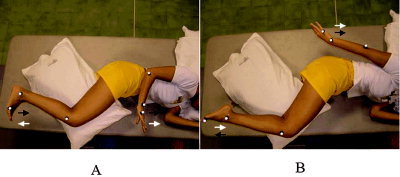Figure 1.

Limb positions during the prone‐anterior (A) and the prone‐posterior conditions of the experiment (B). In panel A, the upper arm is positioned as follows: shoulder in neutral position, elbow flexed at 90°, and forearm in prone position. The lower limb is positioned with both hip and knee flexed at 40°. In B, the upper arm is positioned as follows: shoulder extended at 40°, elbow in maximal extension, and forearm in prone position. The lower limb is positioned with both hip and knee flexed at 40°. The kinematic acquisition was done with markers placed on the head of the fifth metatarsus, the lateral malleolus, the fibula head, the lateral homerus condyle, the styloid ulnae, and the head of the fifth metacarpus. The subjects were asked to move simultaneously their hand and foot, both in phase (black arrows) and antiphase (white arrows). [Color figure can be viewed in the online issue, which is available at www.interscience.wiley.com.]
